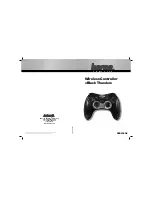
8310CE
8310CE
8310CE
8310CE –
–
–
– Closed
Closed
Closed
Closed----Loop Picomotor Actuator
Loop Picomotor Actuator
Loop Picomotor Actuator
Loop Picomotor Actuator
User Manual
User Manual
User Manual
User Manual
90092094 Rev. A – EDH0418En1010 – 11/19
8
2.0
Mounting the Motor
The mounting shaft is 0.375”—typical in standard micrometers. We have provided a
threaded nut, so you can insert the motor into a bushing and tighten the nut to mount the
motor. This is the preferred mounting method because it reduces the possibility of
distortion on the motor’s housing.
If instead you’re going to mount the motor’s shaft in a micrometer clamp, be careful not
clamp too hard on the motor’s housing. This can deform the motor’s shank and may
cause in-creased friction between the inner rotating screw and the fixed exterior
housing. If the motor slows or fails completely, try loosening the clamp.
You can turn the motor manually using the hex nut at the end of the screw. Please be
careful, however, not to touch the threads of the screw with your tools. Any damage to
the screw threads will result in a significantly shorter motor lifetime. (See the Tips for
Achieving Nanometer-Scale Performance below).
3.0
Tips for Achieving Nanometer-Scale Performance
The Model 8310CE closed loop Picomotor™ actuator offers <1
µ
m repeatability when
approaching a target encoder count from any direction, <0.5
µ
m repeatability when
approaching from a single direction, and 52.9 nm encoder resolution. (The actual
inherent motor step size is considerably smaller—approximately 20 nm). To achieve
consistent nanometer-level performance, you need only keep a few precautions in mind.
•
Use a small amount of lubricant between the stainless-steel ball tip and the load
surface to prevent wear and the generation of debris in the interface. We recommend
Krytox GPL 205 or the low-vapor pressure Krytox, LVP grease.
•
Keep the interface between the stainless-steel ball tip and the load surface clean of
debris. Even small particles on the order of a micron can result in 0.1 to 10 µm
differences between the encoder reading and the actual moved distance.
•
Use the Model 8310CE for pushing against smooth, hard, flat surfaces only, such as
the sapphire pads used in Newport mirror mounts and translation stages. Pushing on
aluminum or stainless-steel surfaces will wear out the ball tip. If the load surface is
too soft, small amounts of material can build up in the interface between the ball tip
and load surface resulting in surface roughness which can degrade repeatability.
•
Do not push against cone or v-shapes, especially in softer materials such as
aluminum. When the ball wears against a cone or v-shape in softer materials,
particle generation can lead to increased friction and torsional loads. These torsional
loads can easily exceed the torsional load limit of 2.5 oz-in (0.018 N•m) thus stalling
the motor.
•
Avoid damage to the screw threads. Do not touch the screw threads with any hard
object—even lightly. To provide the fine resolution, the screw has very fine-pitch
threads. If the threads are damaged, this damaged area will produce repeated
excessive wear within the fixed motor housing and significantly reduce the lifetime
of the motor.






























